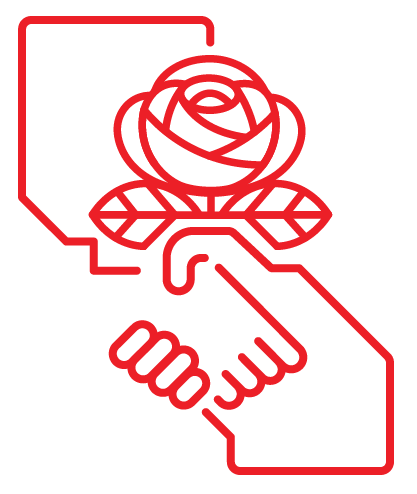Why the U.S. celebrates Labor Day about four months late
Illustration by Jos Sances. In 1889 the Socialist Second International called for commemorating the martyrdom of the immigrant worker leaders of the eight-hour day struggle with a May Day holiday.
[This article originally appeared on Labor Day in the San Francisco Chronicle, but it’s behind a paywall. Enjoy it for free in California Red.]
It was supposed to be May Day.
The May Day holiday—International Workers Day—is currently celebrated by over one hundred countries across the earth. Only in the United States and Canada is a similar holiday—Labor Day—held in September.
This is ironic, because the events inspiring the birth of May Day occurred here.
Most people have a vague understanding of the problems faced by the working class in the nineteenth century, before passage of any meaningful laws regulating the workday or limiting the ability of capital to control the lives of workers. But the realities were often far worse than we might imagine today.
Bloody harvest
Ten, twelve and even fourteen-hour workdays, six or sometimes seven days a week, were the norm in many industries. Factories were filled with machines tended by workers. Moving parts were exposed, and employers considered protections like guardrails too expensive to install. No laws required such measures, and no penalties came with worker casualties. In those regulation-free workplaces, each year brought a bloody harvest of worker injuries and deaths, with most occurring in the final hours of the long workday as workers grew tired and careless.
Which is why, beginning in the 1860s, shortly after the conclusion of the Civil War, arose a movement for a standard eight-hour workday. As the slogan of the time had it, workers wanted “Eight hours for work, eight hours for rest, eight hours for what we will.”
In California, the second state law in the country (following Illinois) established the eight-hour day in 1867. But without any enforcement mechanisms, it proved meaningless when the newly completed transcontinental railroad carried unemployed workers by the thousands seeking jobs across the country to the Golden State a few years later. The glut of labor reduced wages and lengthened the workday.
The arrogance felt by employers toward their employees at the time was exemplified by statements like that of George Baer, owner of the Reading Railroad, who promised that “The rights of the laboring man will be protected, and cared for, not by the labor agitator but by the Christian men to whom God has given control of the property interests in this country.”
General strike for the eight hour day
Workers and their unions saw things differently. In 1886 the American Federation of Labor asked its member unions to call a general strike on May first to support the campaign for the eight-hour day.
A third of a million workers answered the call and walked off the job, hoping to achieve the limit with their action.
But in the wake of the strike, in Chicago, a demonstration protesting police violence against strikers was disrupted by a bomb in Haymarket Square. Although no one was ever identified as the bomb thrower, a lynch mob atmosphere, whipped up by anti-union employers, put eight immigrant radical worker leaders on trial, and several were hung. The prosecution admitted that no evidence connected these leaders with the bomb, but wanted to make an example of them. The nation’s first Red Scare, predating McCarthyism by some six decades, took hold. Advocacy for workers was equated with anarchism and communism. Eight hours for work had to wait for another day.
In Europe, the Socialist International in 1889, condemning the martyrdom of the eight-hour day leaders in Chicago, proposed commemorating their cause with a workers’ holiday on May 1.
A few years later, following massive labor-capital battles like the Homestead Steel Strike in 1892, in the midst of the Pullman strike in summer 1894, in which workers were killed by police, the national guard and armed thugs employed by the railroads, President Grover Cleveland thought a little steam might be let out of the pressure cooker of class struggle. He put his pen to a bill proclaiming that henceforth, the first Monday in September would be a holiday celebrating the contributions of workers to America. This bill made no mention of the eight-hour day or the repression of the workers’ movement. Under these circumstances Labor Day was, in effect, an employer-friendly substitute for May Day.
Elsewhere, in country after country, mass worker movements pushed their governments to sign May 1 into law as a paid workers’ holiday, in many cases via the same general strike tactic.
Fifty more years
It took fifty years before the eight-hour day became the law of the land here, when FDR signed the Fair Labor Standards Act in 1938, in the wake of the largest upsurge of worker militancy since the nineteenth century. But May Day never even came close.
The history of May Day was not taught in our schools. Its public memory was suppressed by selective association with Communist countries that celebrated it, ignoring both its American origins and the democracies that observed it as well. During the Cold War, seeking to drive a final stake through the coffin of May Day memory, Dwight D. Eisenhower proclaimed May 1 to be “Law Day”.
In recent years, May Day—like the labor movement itself—has been making something of a comeback. Here in the Bay Area central labor councils have jointly called May 1 marches and demonstrations—something unthinkable during the long years of the Cold War.
As we celebrate Labor Day, by all means, let’s go get the deals at “big Labor Day savings” sales, and grill hot dogs or meatless substitutes over our backyard BBQs. Take the day off work. We all deserve it. But also take a moment to recall that Labor Day was the original meatless substitute.
And come May 1 next year, look around for and help organize the nearest demonstration.

